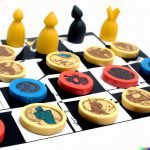The Classic Monopoly Board Game 1964 Edition has captivated generations of board game enthusiasts and collectors alike. From its humble origins in early 20th century America to its iconic status today, this timeless game continues to bring joy and excitement to players around the world.
With its unique design and gameplay mechanics, the 1964 edition holds a special place in the hearts of those who grew up playing it. In this article, we will explore the history of the Monopoly board game, delve into the features of the 1964 edition, discuss its rarity and collectible value, provide insights into gameplay experience, compare it to later editions, offer tips on collecting and pricing, and examine its nostalgic appeal.
For decades, Monopoly has been a staple in households worldwide. It has become synonymous with family gatherings, rainy days indoors, and friendly competitions among friends. The enduring popularity of this classic board game can be attributed to its ability to bring people together, while also challenging their strategic thinking and financial acumen.
The 1964 edition of Monopoly is particularly notable as it represents a significant milestone in the evolution of the game. With updated player tokens or revised gameplay rules, each new edition brings fresh excitement and allows players to experience Monopoly in new ways. This article will explore these unique elements and design aspects specific to the 1964 edition that continue to enchant collectors and enthusiasts alike.
Whether you are an avid collector looking for rare editions or simply someone who cherishes memories of playing Monopoly as a child, this article will offer valuable insights into what makes the Classic Monopoly Board Game 1964 Edition so beloved and sought-after. Let us now dive into the rich history behind this iconic game and discover why it continues to hold a special place in our hearts.
History of the Monopoly Board Game
The history of the Monopoly board game is a fascinating journey that traces back to the early 20th century in America. It all began with an American woman named Elizabeth Magie, who designed a game called The Landlord’s Game in 1903.
The Landlord’s Game had a striking resemblance to what we now know as Monopoly, featuring properties, rent, and even Chance and Community Chest cards. Magie’s intention was to expose the unfairness of capitalism and promote Henry George’s ideas on land value taxation.
Over the years, The Landlord’s Game evolved and went through various iterations before it eventually caught the attention of Charles Darrow. In 1934, Darrow made his own version of the game using materials like linoleum remnants for the game board and a charm bracelet for player tokens. He sold this homemade version of Monopoly in local department stores, which gained popularity among players.
Recognizing the potential popularity of Monopoly, Parker Brothers acquired its rights in 1935 and officially released it as a commercial product. The release of Monopoly proved to be an instant success, capturing the hearts of many families who enjoyed the strategic gameplay and competitive nature it offered.
Throughout its history, several milestones shaped Monopoly into what it is today. In 1964, Parker Brothers released a notable edition that featured updated artwork and graphic design elements. This edition saw changes such as streamlined typography and vibrant colors that enhanced the visual appeal of the game board.
The 1964 edition also introduced new community chest cards with modern themes relevant to that era. These small yet significant modifications added to the overall experience of playing Monopoly and kept it fresh for both longtime fans and newcomers alike.
Features of the 1964 Edition
The 1964 edition of the classic Monopoly board game introduced several unique elements and design aspects that set it apart from previous versions. One notable modification in this edition was the introduction of updated player tokens. While earlier editions featured metal tokens, the 1964 edition replaced them with plastic tokens in vibrant colors.
These new tokens included a battleship, cannon, horse and rider, iron, shoe, top hat, thimble, and wheelbarrow. This change added to the visual appeal of the game and provided players with a fresh experience.
In addition to the updated player tokens, the 1964 edition also made revisions to the gameplay rules. One significant change was the introduction of a speed die. This additional die was rolled along with the regular dice and added an element of unpredictability to the game.
Depending on what number was rolled on the speed die, players could move even quicker around the board or face obstacles that slowed their progress. This new feature brought a dynamic twist to gameplay and increased strategic decision-making for players.
Furthermore, the 1964 edition featured revised property cards that included a more modern design aesthetic compared to previous versions. The cards used bold fonts and vibrant colors to denote different property types, making them easier to identify at a glance during gameplay. Additionally, property rents were adjusted based on inflation rates since previous editions had been released. The revised property values reflected real-life changes in prices and added an extra layer of realism to the game.
Overall, these modifications and additions in the 1964 edition enhanced both the visual appeal and gameplay experience of Monopoly. The updated player tokens injected more color into the game while maintaining their iconic status, while revised rules and property cards added depth and relevance to reflect changing times. These features contributed to its lasting popularity among collectors who appreciate not only its nostalgic value but also its unique elements that distinguish it from other editions.
| Unique Elements in the 1964 Edition | Features |
|---|---|
| Updated Player Tokens | New plastic tokens in vibrant colors |
| Revised Gameplay Rules | Inclusion of a speed die for added dynamics |
| Modernized Property Cards | Bold fonts, vibrant colors, and adjusted property values |
Rare and Collectible
Rarity of the 1964 Edition
The 1964 edition of the classic Monopoly board game holds a special place in the hearts of collectors due to its rarity. This particular edition was not produced in large quantities, making it more difficult to find compared to other versions of the game. The limited production runs contribute to its desirability among collectors, as it adds an element of exclusivity and scarcity.
Furthermore, the 1964 edition of Monopoly featured several unique elements that set it apart from other editions. The game includes a distinctive box design and artwork that differs from subsequent versions, as well as specially designed player tokens that were exclusive to this edition. These factors add to the overall rarity and collectible value of the 1964 edition.
Special Edition Versions
In addition to its rarity due to limited production, there are also special edition versions of the 1964 Monopoly board game that hold particular appeal among collectors. These special editions often feature additional components or unique themes that further enhance their desirability.
For example, there is a coveted Deluxe Edition of the 1964 Monopoly game that includes a larger playing board, deluxe wooden houses and hotels, and gold-toned player tokens. This deluxe version is highly sought after by collectors due to its exquisite craftsmanship and enhanced gameplay experience.
Other special edition versions may have tie-ins with popular franchises or events, such as commemorative editions released for anniversaries or collaborations with iconic brands like Coca-Cola or Disney. These special editions often feature custom artwork and components that make them even more valuable and collectible for enthusiasts.
Collector’s Market Value
The rarity and desirability of the 1964 edition of the Monopoly board game contribute significantly to its market value among collectors. Authentic copies in good condition can fetch high prices on the collector’s market.
When evaluating the value of a 1964 edition, factors such as the completeness of the game, the condition of the components and box, and any additional special editions or unique elements present can impact its worth. Collector’s marketplaces, online auctions, and vintage game stores are common avenues for acquiring and assessing the value of this edition.
It is important for collectors to research and consult with experts or experienced collectors to ensure they are purchasing authentic copies. Additionally, understanding the pricing dynamics within the collector’s market can help collectors make informed decisions when buying or selling their prized 1964 Monopoly board game editions.
Gameplay Experience
The gameplay experience of the 1964 edition of Monopoly offers players a classic and immersive board game experience. The mechanics of the game remain consistent with other editions, where players roll dice to move around the board, buy properties, collect rent, and aim to bankrupt their opponents. However, there are some specific elements in the 1964 edition that add unique flavor and strategy to the gameplay.
One notable feature of the 1964 edition is the inclusion of updated player tokens. While earlier versions often featured metal tokens, such as a ship or a racecar, the 1964 edition introduced plastic tokens in various shapes and colors. Players could choose between a battleship, top hat, horse and rider, cannon, wheelbarrow, thimble, shoe, iron, or dog. These tokens not only added visual appeal but also allowed players to express their individuality through their choice.
In addition to updated player tokens, the 1964 edition introduced revised gameplay rules and strategies. One key difference is the increase in available properties for purchase. With additional options for building up monopolies on different color sets or using strategic trade-offs among players early on in the game was crucial in acquiring key properties before they were monopolized by others.
To maximize enjoyment and success during play in the 1964 edition of Monopoly, players can employ various tips and strategies. One effective strategy is to focus on obtaining complete color sets as quickly as possible since these sets enable players to charge higher rents on those properties. It is also important to strike a balance between investing in properties and saving money for potential emergencies like paying rent or getting out of jail.
Overall, playing the 1964 edition of Monopoly provides an enjoyable and strategic experience for board game enthusiasts. The combination of updated player tokens, revised gameplay rules, and various strategic options make this version unique while still capturing the essence of this beloved classic game.
| Gameplay Experience Elements | Description |
|---|---|
| Player Tokens | Updated plastic tokens in various shapes and colors |
| Revised Gameplay Rules | Increase in available properties for purchase, emphasizing the importance of early acquisition and strategic trade-offs among players. |
| Tips and Strategies | Focusing on obtaining complete color sets, balancing investments with saving money for emergencies, such as paying rent or getting out of jail. |
Comparisons to Later Editions
When comparing the 1964 edition of the classic Monopoly board game to later editions, it becomes apparent that there have been significant changes and differences in terms of gameplay, design, and features. One notable difference is the evolution of the player tokens used in the game.
In the 1964 edition, players could choose from familiar metal tokens such as the Scottie dog, top hat, and race car. However, subsequent editions introduced a wider variety of tokens, including popular culture icons like an emoji or a T-rex.
The design of the board itself has also undergone changes in later editions. While the 1964 edition featured a colorful square board with distinct properties and spaces for Chance and Community Chest cards, newer versions have experimented with different layouts and themes. For example, some later editions introduced circular boards or redesigned property names to reflect different cities or landmarks around the world.
In terms of gameplay, later editions have often introduced new rules or mechanics to freshen up the experience. For instance, certain iterations included speed die that allowed players to move more quickly around the board or special action cards that added unexpected twists to gameplay. These additions aimed to provide a new level of excitement and strategic depth for fans who were already familiar with the classic version.
Overall, while preserving many core elements that made Monopoly beloved since its inception, later editions have sought to innovate and modernize aspects of gameplay and design. Through these changes, each subsequent edition brings its own unique flavor while staying true to the timeless appeal of this classic board game.
Collecting and Pricing
For collectors seeking to acquire a 1964 edition of the Classic Monopoly Board Game, there are several avenues to explore. One option is to search for authentic copies at local flea markets, garage sales, or estate sales. These types of venues often offer hidden treasures and can provide an opportunity to find a vintage copy at an affordable price.
Another option is to visit specialized board game stores or online auction sites that cater to collectors. These platforms often have a wide selection of vintage games available for purchase.
When evaluating the value of a 1964 edition of Monopoly, it is essential to assess its condition thoroughly. Look for signs of wear or damage, such as missing pieces, fading artwork, or tears in the board or box. A copy in excellent condition with all original components intact will typically command a higher price in the collector’s market.
Understanding the pricing dynamics within the collector’s market is crucial for both buyers and sellers. Factors that contribute to the value include rarity, demand among collectors, historical significance, and any special features unique to that edition. Keep in mind that certain editions may have limited production runs or variations that make them more desirable among collectors.
It’s also worth noting that collecting Monopoly games can be a niche hobby with a passionate community. Connecting with fellow collectors through forums or attending conventions and meetups can provide valuable insights into current trends and pricing information. Additionally, consulting reputable price guides specifically tailored for vintage board games can help collectors accurately determine fair market values.
Nostalgia and Nostalgic Appeal
The 1964 edition of the Monopoly board game holds a special place in the hearts of many players, as it is often revered for its ability to evoke a strong sense of nostalgia. The game’s iconic design, artwork, and components can transport players back to their childhoods, stirring up memories of countless hours spent rolling dice, buying properties, and making deals with family and friends.
The vintage aesthetic of the 1964 edition adds to its nostalgic appeal, capturing a bygone era and reminding players of simpler times.
For many individuals, playing Monopoly was a cherished ritual enjoyed with loved ones. Whether it was gathering around the kitchen table on a rainy Sunday afternoon or during family get-togethers during holidays, this classic edition played an integral role in creating lasting memories and fostering bonds between generations.
The tactile sensation of handling the money and the property cards, as well as moving familiar tokens like the top hat or thimble across the board, can instantly transport players back in time.
The enduring appeal of the 1964 edition lies not only in its ability to evoke nostalgia but also in its timeless gameplay mechanics. While modern iterations may have introduced new twists or licensed versions featuring popular franchises, such as Star Wars or Game of Thrones, there is something inherently charming about returning to the original classic version that hasn’t changed much over the years.
The simplicity of buying properties, collecting rent, and strategically maneuvering around the board continues to captivate players young and old alike.
Additionally, collectors are drawn to this particular edition due to its historical significance within board game culture. As one of the earliest editions released after Parker Brothers standardized the game, the 1964 edition represents a pivotal moment in the evolution of Monopoly. Its continued popularity within the collector’s market is a testament to its enduring appeal and the special place it holds in the hearts of many players.
Conclusion
In conclusion, the Classic Monopoly Board Game 1964 Edition holds a special place in the history of board games and is a highly sought-after collector’s item. Its enduring appeal lies not only in its gameplay mechanics but also in the nostalgia it evokes for many players. This edition represents a significant milestone in the evolution of the Monopoly game, with its unique design aspects and notable modifications.
The 1964 edition of Monopoly showcases the evolution of this beloved game, capturing a snapshot of its journey throughout the years. From updated player tokens to revised gameplay rules, this edition offers a distinct experience that sets it apart from later versions. The rarity and collectible value of this edition add to its desirability among collectors, with limited production runs and special edition versions further enhancing its appeal.
For those interested in adding the Classic Monopoly Board Game 1964 Edition to their collection, understanding how to source authentic copies and evaluate their condition is crucial. The pricing dynamics within the collector’s market should also be taken into account when assessing its value. Acquiring this edition not only allows collectors to possess an iconic piece of board game history but also gives them an opportunity to immerse themselves in the nostalgia associated with childhood memories and family bonding.
Overall, the Classic Monopoly Board Game 1964 Edition remains a cherished item that continues to captivate board game enthusiasts and collectors alike. Its enduring appeal and value stem from its significant place in board game history and its ability to transport players back to a simpler time when gathering around a table for hours of exciting gameplay was a cherished pastime.
Frequently Asked Questions
Are old Monopoly board games worth anything?
Old Monopoly board games can indeed be worth something, but it really depends on the specific game and its condition. Generally speaking, vintage or antique Monopoly games from the early 20th century tend to have more value than those from later years.
Additionally, factors like limited edition versions, unique artwork, or special features can further increase their worth. It’s important to note that rarity plays a significant role in determining value, so older games that are less common are typically more sought after by collectors.
How much would an original Monopoly game be worth?
The value of an original Monopoly game can vary greatly depending on various factors. The first commercially produced Monopoly games were introduced in 1935 by Parker Brothers, and these early editions are generally considered the most valuable among collectors.
However, other factors such as the game’s condition, completeness (including all original pieces and instructions), and any unique features or special editions can significantly affect its worth. While it is challenging to provide a specific value without more details about a particular game, it is recommended to consult with reputable collectors or appraisers to obtain a more accurate estimation.
What is the rarest edition of Monopoly?
The rarest edition of Monopoly is often regarded as the 1933 “Prototype” edition. This version was created by Charles Darrow before he pitched his design for Monopoly to Parker Brothers. Only a very limited number of these prototypes were handmade by Darrow himself before he sold the rights to Parker Brothers in 1935.
This edition featured circular wooden properties instead of rectangular cards and had distinct differences in design compared to later versions. Due to its extreme scarcity and historical significance as the precursor to one of the world’s most famous board games, the 1933 “Prototype” edition holds immense value among collectors and enthusiasts alike.

I love playing all kinds of games – from classics like Monopoly to modern favourites like Ticket to Ride.
I created this blog as a way to share my love of board games with others, and provide information on the latest releases and news in the industry.





